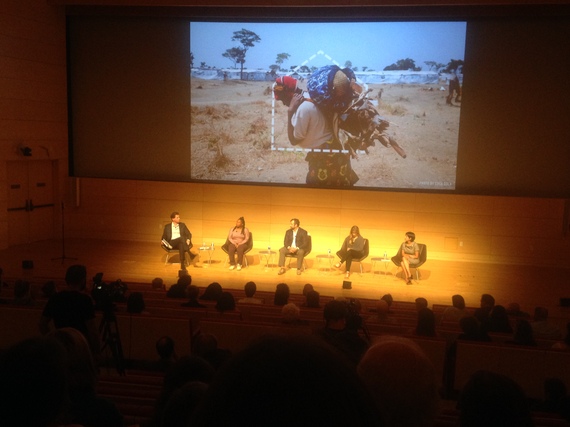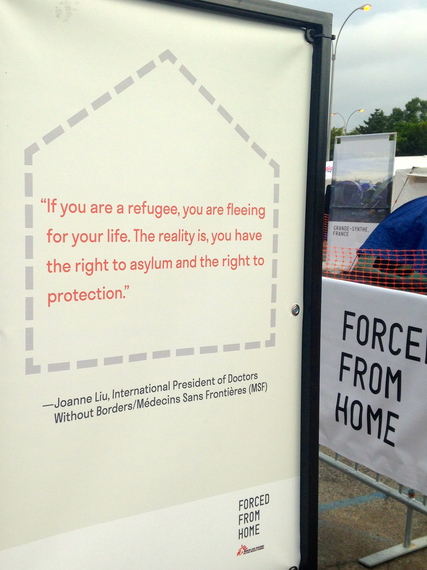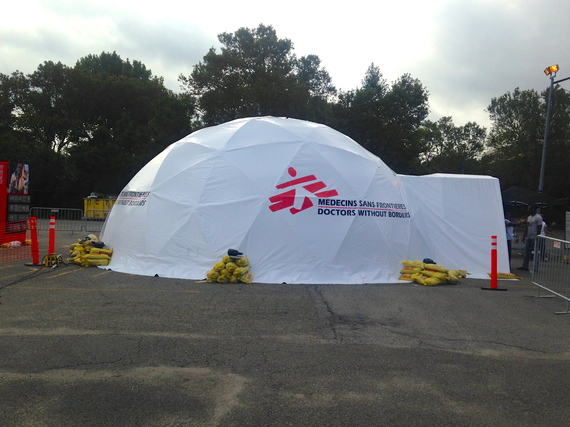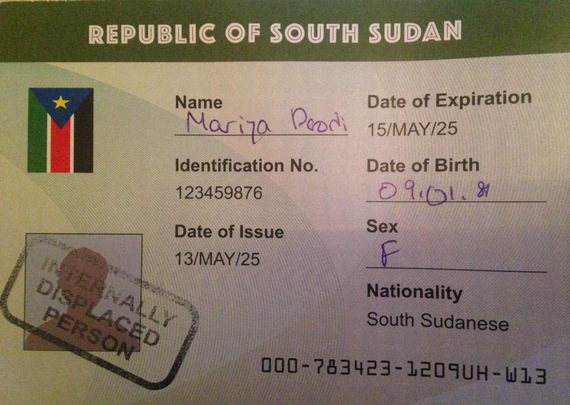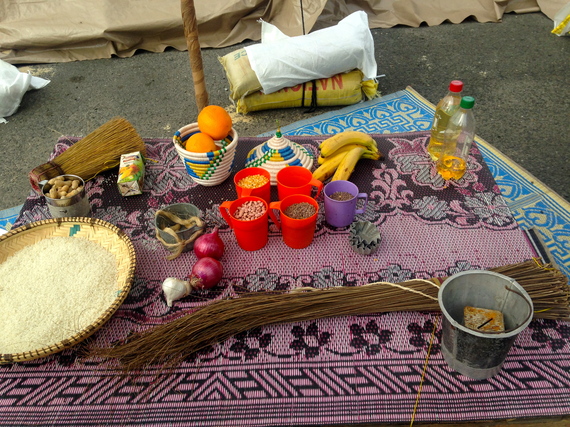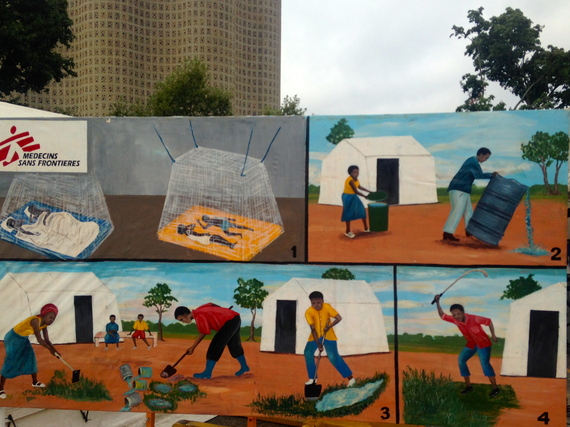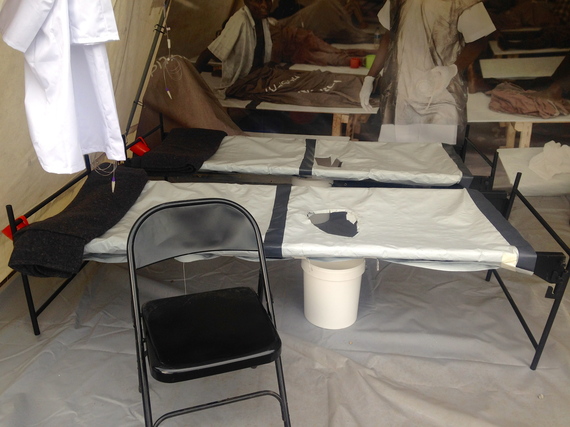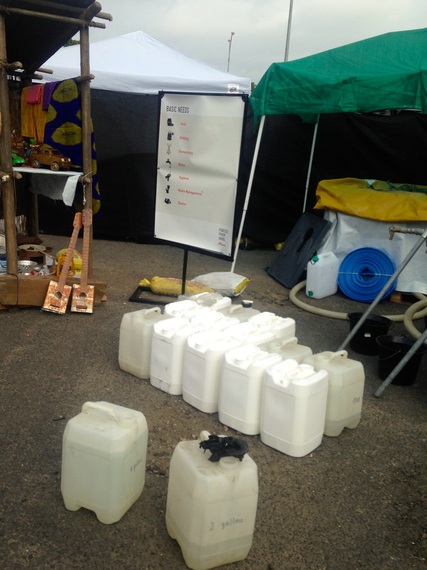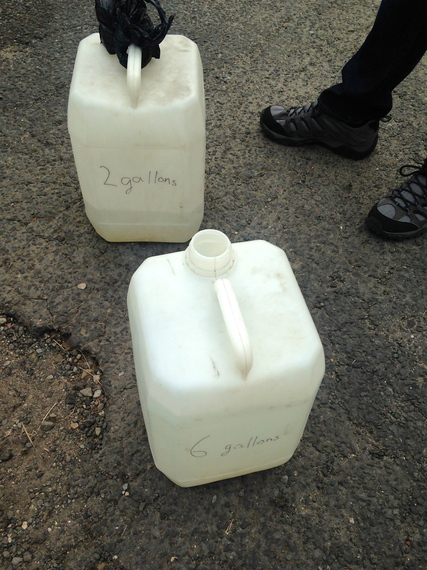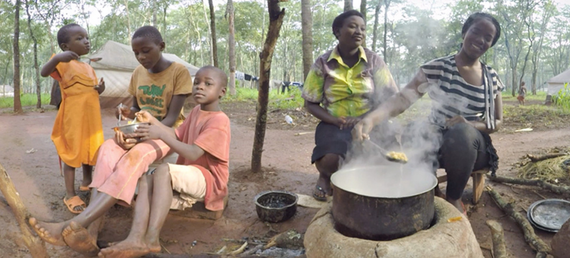On Tuesday, September 13, Médecins Sans Frontières / Doctors Without Borders, held an event to kick off its Forced From Home tour--an interactive, educational exhibition presented to raise awareness about the world's refugees and internally displaced people, with experienced aid workers as guides.
Black and white photo of a Doctors Without Borders Forced From Home postcard. Photo credit: MSF
Today there are 65 million people worldwide who have been forced from home and "every one of those 65 million is an individual story", as stated Bryan Walsh, Foreign Editor of TIME magazine who moderated the kickoff event in NYC. Last year alone, about 24 people were forced to flee each minute. When MSF hosted this kind of tour previously in 2009, there were 33 million worldwide; meaning the number has almost doubled in the last 7 years. A third of the 65 million are refugees who have been forced to flee by violence, persecution, torture, war, the majority are IDPs, or internally displaced people, who have been forced to flee their home but have remained within their country's borders, including in formal camps and makeshift camps. In 2015, 12.4 million people were displaced, about 34,000 men, women, and children who left their homes and their lives each day to find safety elsewhere within their countries.
Photo of the opening Forced From Home panel on September 13, 2016 at the New School. Photo credit: Mariya Parodi
Who are these people and why did they leave? That has been a question MSF has attempted to answer. These individuals are mothers, fathers, sisters, brothers who have had to make impossible choices every day, choosing between leaving a spouse or a parent, one child over another. MSF has served as a bridge between us and them, attempting to close the distance between us, physical and emotional.
"Mothers will do just about anything to get good healthcare" says Dr. Africa Stewart, a doctor focusing on obstetrics and gynecology and a Forced From Home tour guide. Dr. Stewart has completed four assignments with MSF, in Sudan, South Sudan, and Nigeria. The answer for a question like "which child do I choose?" is often answered by "which child am I still nursing?" shares Dr. Stewart. "I'm a mom. I get it. I'll do it if it might be right for my babies". We forget women do not make the choice to leave, but are rather forced, that "most moms want to be surrounded by family and friends" and that they too were "a friend of a friend of a friend" once- vital members of their communities.
Often, a large part of the services are not just providing care, but providing knowledge to the patient on their future healthcare--"this is what you will say to the next doctor you see" advises Dr. Africa Stewart. She finds providing that information is the same whether working on the field abroad or back stateside in Georgia, where the OBGYN serves as an emergency room for undocumented women. No matter where MSF operates, it provides healthcare, as well as safety and support to its patients, which means if the mother need to be in a hospital, the children are welcome and the same holds true for a child that falls sick and the siblings are welcomed to stay.
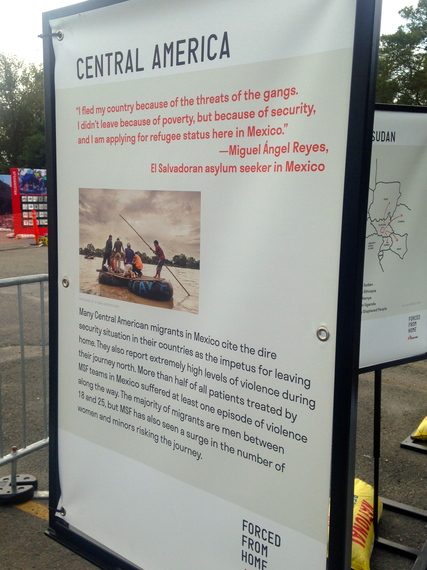
An MSF poster at the Forced From Home exhibit at the New York Hall of Science
Jason Cone, MSF-USA Executive Director reminds us not to forget they journey that migrants make--that they too are forced from home and they too are forced to make a journey they would not otherwise make had they safety, economic opportunities, or simply adequate food. Women fleeing Central America often take birth control knowing they will be subject to rape and sexual violence. They do not make such a dangerous journey because they see a future at home, instead, to quote Dr. Africa Stewart, "the possibility of freedom is real" to them. For such freedom, those fleeing brave traffickers, gangs, corrupt border guards, physical violence, psychological duress, and the threat of death.
Last year, MSF treated 11,100 patients medically for sexual violence and conducted 106,500 major surgical interventions, including obstetric. For Dr. Stewart, surgical repair is the part she hates the most and yet is the most needed. "It hurts every time and it doesn't go away" she says. "I always say I'll never go back and I always do". The reason she does, she explains with a smile, is because when she know when she "leaves this world", she wants to be "the person that said I will", that was needed, that was asked, and gave a resounding yes, knowing she was needed. Because of that knowledge, Dr. Stewart never felt like she made a mistake in going on humanitarian missions.
In response to the crisis, MSF has launched search and rescue boats in the Mediterranean where 3,675 have gone missing in 2015. It has placed pressure upon pharmaceutical companies to make life-saving vaccinations available to those fleeing, provided emergency obstetrics, mental health counseling, nutritional services, and access to safe drinking water. The Forced From Home tour sheds light on the crisis as well as ways MSF responds.
Before beginning the tour, participants are asked to pick 5 items from a choice of 20 that they could bring as they flee their homes. These include clothes, jewelry, children's toys, a bicycle, a wheelchair, a guitar, footwear, money, fishing equipment, pets, medication, a phone, keys, water, a sewing machine, photos, scarves, a passport, food, and baby formula. For me this meant 1) a phone 2) a passport 3) medication 4) money 5) and photos. As the journey progresses, each participant is asked to give up one item to 'pay' for each step in the journey. For example, for me to get in a dingy to flee, I gave up my passport, followed by my money, photos, medication, and finally all I had left was my phone. For my my husband, his last item was our family photos and as he lamented he would not have been able to get in touch with me were we making this journey, we had a taste of how decisions are made for those fleeing with each step they take.
Participants in a dingy at the MSF Forced From Home exhibit
In reality, as Dr. Africa Stewart explains, people have to leave their home without looking as if they are leaving. If they escape with luggage, items such as clothes or family photos that we as participants had the options to choose from, they would look suspicious and often be unable to make their escapes. Instead, they must look like they are just going to the market or going out to see a friend and must organize as much as possible in the folding of their clothes.
A painting at the MSF Forced From Home exhibit
"It's hard to prioritize" says Michelle Mays, nurse and project coordinator for MSF programs. For MSF, choices have to be made as well as to what to prioritize first in response. In Nigeria, Michelle witnessed individuals who had fled their homes due to Boko Haram violence using former schools, hospitals, and abandoned buildings for shelter and providing services proved incredibly difficult in such an environment. Although individuals were in need of psychological services, but first needs were an emergency response to physical rather than their psychological needs.
Beds lined up by MSF at the Forced From Home exhibit
As IDPs escape diseases such as Cholera, MSF provides specialized care. In 2015 alone, MSF treated 32,600 people for Cholera. As Cholera can be treated by keeping patients hydrated, beds are set up with individual IVs, as well as buckets for diarrhea & vomiting symptoms, which are then sterilized by staff--even the shoes are sprayed with solution.
MSF exhibit demonstrating water purification and usage
One of the causes of cholera is unsafe drinking water. As refugees and IDPs are susceptible to Cholera, diarrhea, Typhoid, Hepatis A and E, Malaria, and Dengue fever, education on health and WASH or Water, Sanitation and Hygiene, are critical. MSF provides refugee and IDP communities with safe access to water, installing filtration through chlorine packets. WASH services address potential causes of waterborne disease and malnutrition.
The Forced From Home exhibit shed light on the scarcity of water
Water is a scarce resource in the world, including in the camps. One person needs about 6 gallons of water per day. I could barely lift 2 gallons, yet the burden of carrying 6 gallons and more falls to women and young girls. While that water is necessary for drinking, cooking, and hygiene, few have the luxury. In the United States, by comparison, one person uses an average of 90 gallons of water per day.
MSF displays the RUTF
MSF also provides therapeutic feeding programs to children 6 months to 5 years old. To test whether they are malnourished, their wrists are measured by size, categorized by color: green, yellow, and red. If they are severely malnourished, in the red, they are provided with RUTF, or Ready-To-Use Therapeutic Food, of which they must eat 3 packs a day.
MSF mosquito nets
"You are an MSF worker" our Forced From Home exhibit guide, Jon, tells us. We are dealt a case which we must address urgently: a 17 year old girl witnesses her father's murder and flees her hometown, arriving to MSF sick with malaria. What services does she need? Though she may need psychological support, as well as well as medical services following possible sexual violence, what has to be addressed first is malaria Jon stresses, demonstrating the complexities in play in every case of IDPs and refugees MSF treats.
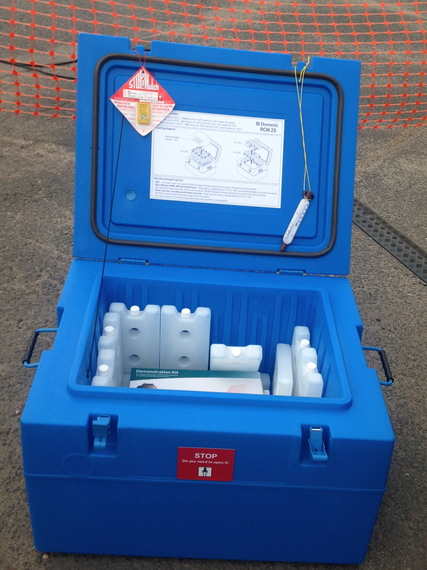
Since most vaccines are sensitive to heat, they must be kept cold through every process of distribution. For vaccines against measles, it's vital to keep them insulated in a cooler
Today, there are 2 million cases of malaria worldwide. Diagnosing it is a matter of minutes, requiring a drop of blood to test and 3 days of medication. MSF provides a drug called Coartem, packaged with images of a sun and a moon for each day, making it accessible for those who are illiterate. Moreover, MSF provides patients with mosquito nets to use when they sleep in order to prevent contracting it again.
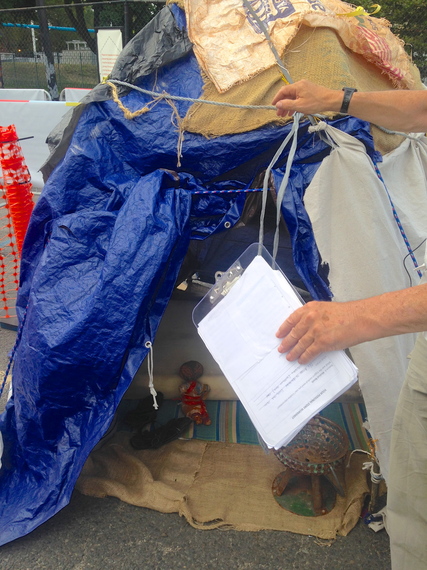
An MSF guide explains to participants varieties of tent: some, like those seen in Nigeria, made from distributed non-food items, others, like those seen in Iraq, which serve as family tents for one large family or for two small ones with sheets serving as walls to create makeshift privacy for the families
For all attending the Forced From Home exhibit, virtual reality transforms them from the exhibit to refugee and IDP camps, as well as makeshift camps. In the 360 degree dome, participants are transported to Greece among lifejackets, Lebanon among shoddy wires and cables, Mexico among handicapped clients and a "Bienvenidos Migrantes" sign, and South Sudan among its dry roads. For those wishing to learn more, but unable to attend, videos are still available.
As Jason Cone, MSF-USA Executive Director highlights, the systems we have today are not set up for protracted displacement, serving merely as band aids to deep-seated wounds. It is the political leadership that must make the decisions to address what lives those fleeing their homes will lead and the New York Declaration on refugees is the first step-- next are a series of steps consisting of pressure from citizens of Europe and the United States who have yet to set an example in equitable leadership on the refugee crisis in the 21st century and a implementation of changes that demonstrates commitment rather than lip service.

